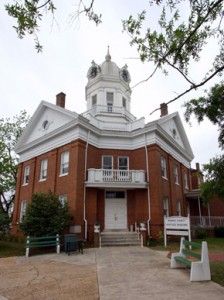July 16th, 2010
After reporting on the 50th Anniversary of To Kill A Mockingbird last week, fellow VISTA Will Thomas and I decided to take a road trip down to Monroeville to check out some of Friday night’s festivities.
We pulled into town at around 5 pm to find a pretty typical small town scene. Much of main street had closed up at 4 pm. Even the courthouse museum’s exhibits on To Kill a Mockingbird and Harper Lee were closed. (Below – Monroeville Historic Courthouse Museum. Photo via Encyclopedia of Alabama)
Turns out most tourists were at a film screening, and the rest of the town and shop owners adhere strictly to traditional schedules – so much so, in fact, that many businesses still close up at noon on Thursday, though nobody could tell us why. After a little research, we figured out that this practice is a holdover from antebellum days, when everyone got off work early to go to the slave market in Mobile on Thursday afternoon.
We killed time by exploring the deserted town square before meandering over to the historic Hybart House (above and below – photos via tokillamockingbird.com) where the evening’s festivities included a small garden party featuring Little Savannah’s home cooking and the weekend’s signature cocktail, Tequila Mockingbird.
Many of the people we met lived in Monroeville or nearby communities. The weather was pleasant, the company was welcoming, and the food was delicious. The menu, themed around “To Kill a Mockingbird,” included fried chicken, turnip greens, heirloom tomatoes, ham and cornbread!
Our dinner companions chatted with us about their lives, their families, and Monroeville. Only one was a Monroe native, and had returned to after many years’ absence. Two of them had moved to Monroeville to follow friends or family working in the timber industry; as one explained it, “Everyone in this town is here because of timber.” The fourth was visiting from Mobile.
Of course we talked about To Kill A Mockingbird: the book, the play, the movie, and the mysterious author. Many of them see her around town, but wouldn’t divulge too much gossip.
We also talked about an article Dr. Wayne Flynt wrote for a Monroeville publication, Don’t Shoot Flawed ‘Mockingbird’. (It also ran in last Sunday’s Birmingham News.) Between this article and the conversation I had with him last week, Dr. Flynt helped me understand the book as a treatise on empathy and decency. It encourages us to ignore fear and prejudice, and to walk in another’s shoes before judging them. And it addresses not only racial prejudice, but social stigma and the class differences that divide us.
Still from the movie adaptation of To Kill a Mockingbird showing Bob and Mayella Ewell.
Many characters in the book are repugnant, and yet despite some extreme character flaws, they are humanized. The same rectitude that leads Atticus Finch to defend Tom Robinson causes him to view even extremely hateful or unlikable people as human beings. He gets beyond fear and dislike of those who are different and tries to see things from their point of view.
I still noticed some defensiveness in Monroeville about the book’s depiction of race relations. A tour guide insisted that such a rape trial had never occurred in Monroeville, even though a similar trial did occur when Harper Lee was 10 years old and Arthur Lett was falsely accused and convicted of rape. And the crowd at the anniversary dinner we attended was overwhelmingly white.
Yet the people of Monroeville still celebrate the book today precisely because it had such a huge impact on social attitudes when it was published. Many people warned me the overtly racist language and subject matter of the play (performed every March) was disturbing, but they felt it was important to remember the uncomfortable truths about their past.
To Kill a Mockingbird is both a nostalgic look back at childhood and a recognition of flawed justice, and when people gather to talk about it, they remember it for both of these reasons.
For more views of Monroeville, check out this CBS Sunday morning story.
Posted by Robyn Hyden







